Abstract
Objectives
It has been widely accepted in the literature that various forms of physical exercise, even in a single session, enhance positive mood. It has also been shown that physical exercise may sometimes enhance creative thinking, but the evidence is inconclusive. Positive moods can favour creative thinking, but the opposite has also been reported and these relations are unclear. There is a large anecdotal literature suggesting that creative people sometimes use bodily movement to help overcome “blocks”. The aim of this study was to establish whether post-exercise creative thinking was attributable to improved mood.
Methods
The responses of 63 participants to an exercise (aerobic workout or aerobic dance) and a “neutral” video watching condition were compared. Mood was measured using an adjective list, and creative thinking was tested by three measures of the Torrance test.
Results
Analysis of variance showed a large and significant increase in positive mood after exercise (P<0.001) and a significant decrease in positive mood after video watching (P<0.001). A significant increase between the creative thinking scores of the two conditions was found on the flexibility (variety of responses) measure (P<0.05). A multifactorial analysis of all data failed to show a significant covariance of creative thinking with the two measures of mood (P>0.05).
Conclusions
These results suggest that mood and creativity were improved by physical exercise independently of each other.
Keywords: physical exercise, mood enhancement, creative thinking
Full text
PDF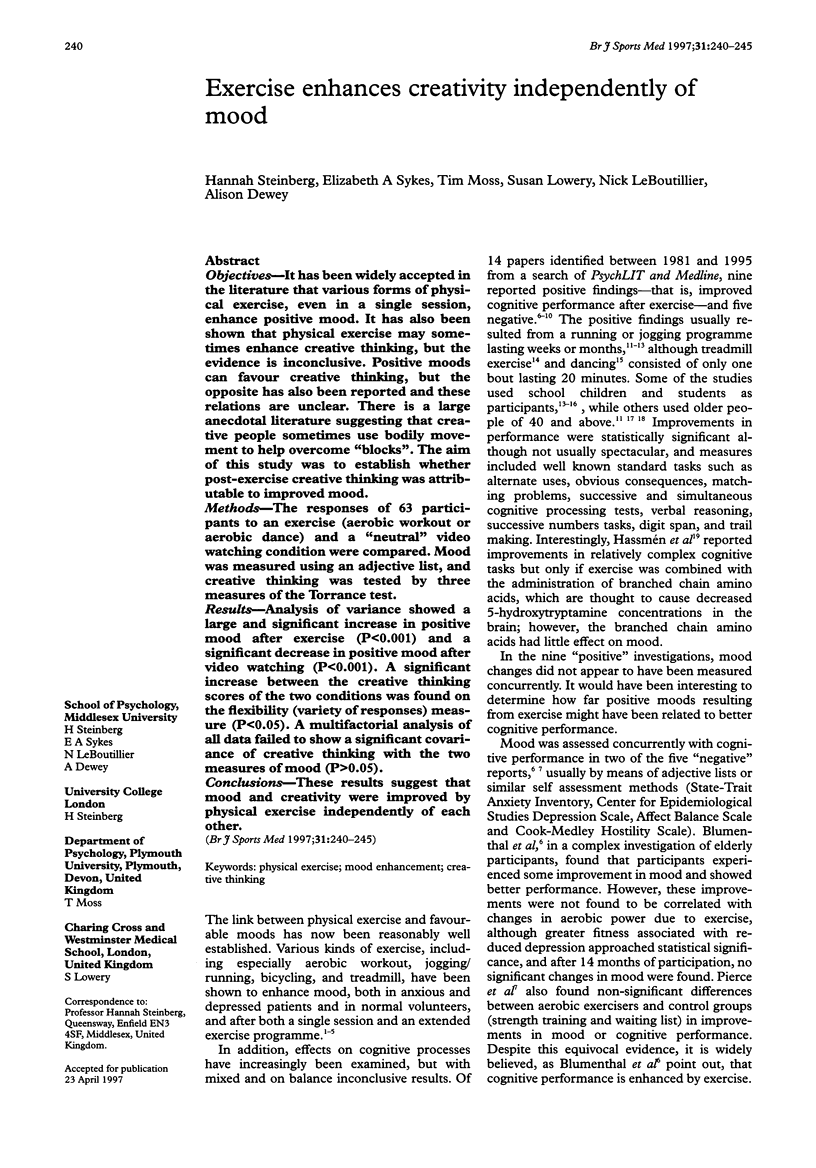
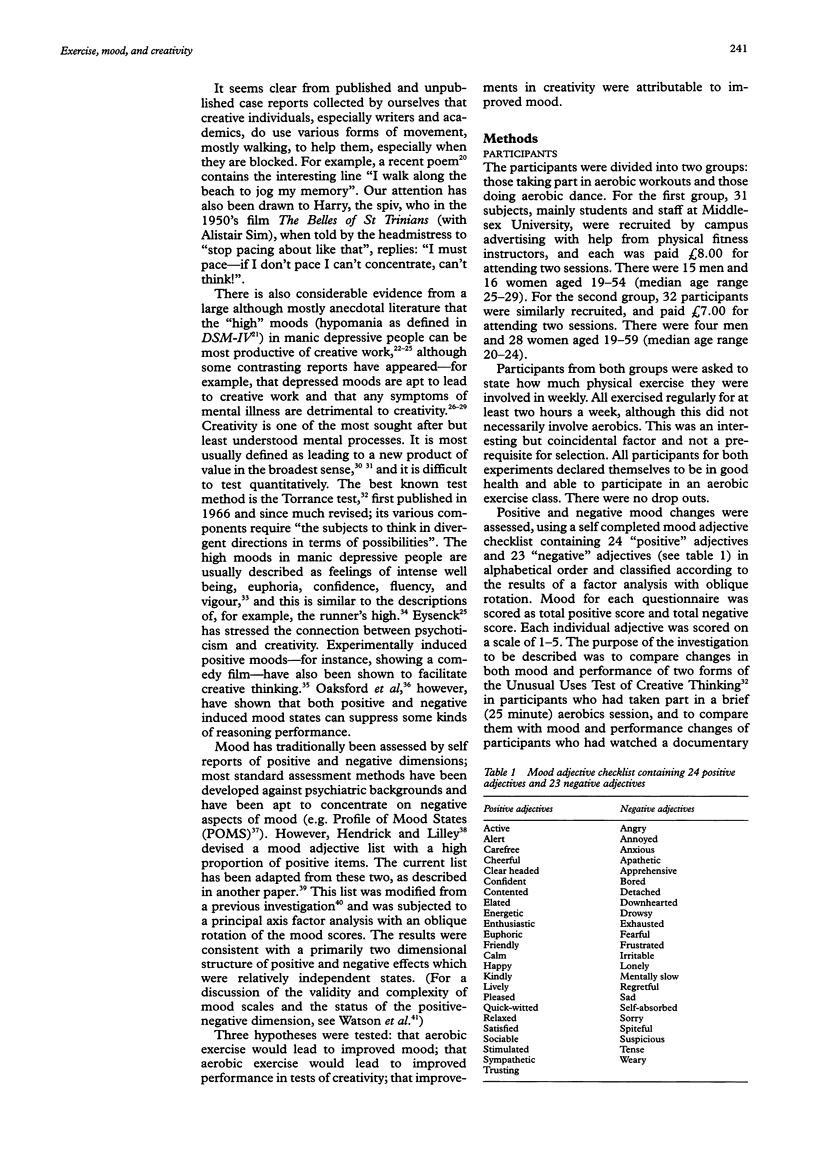
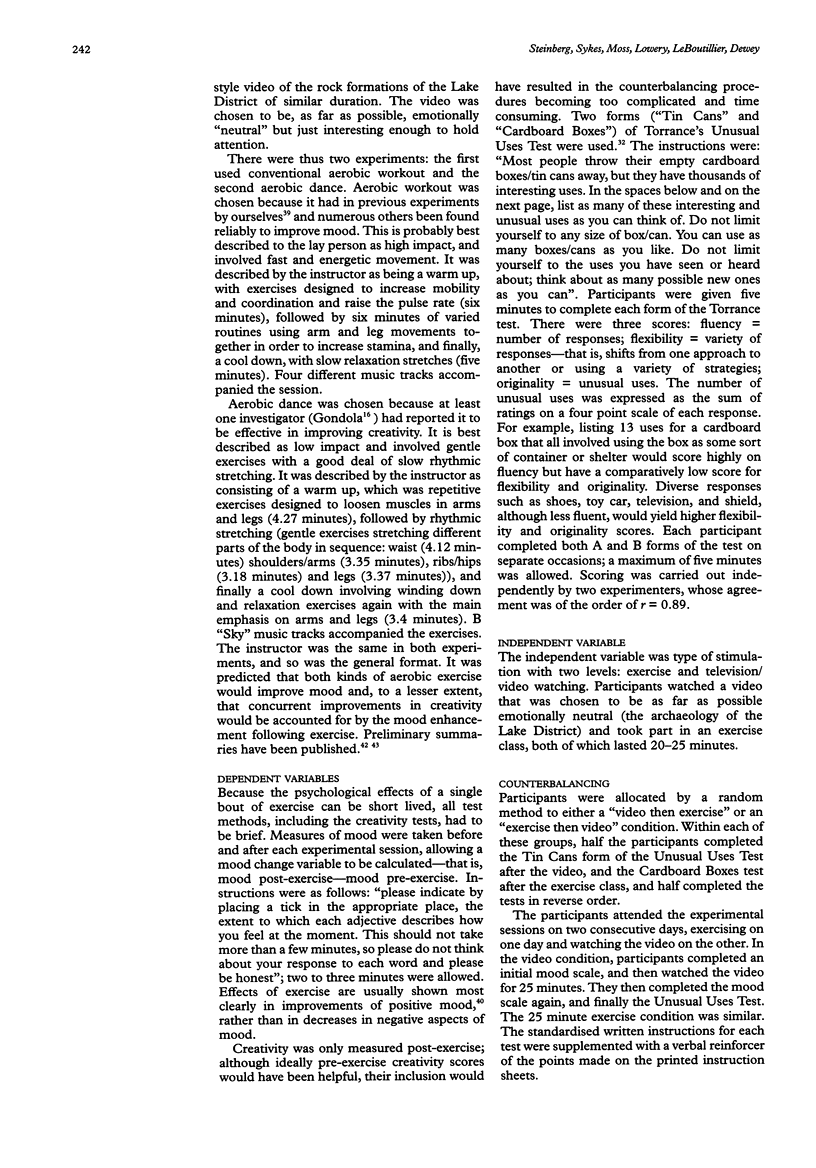

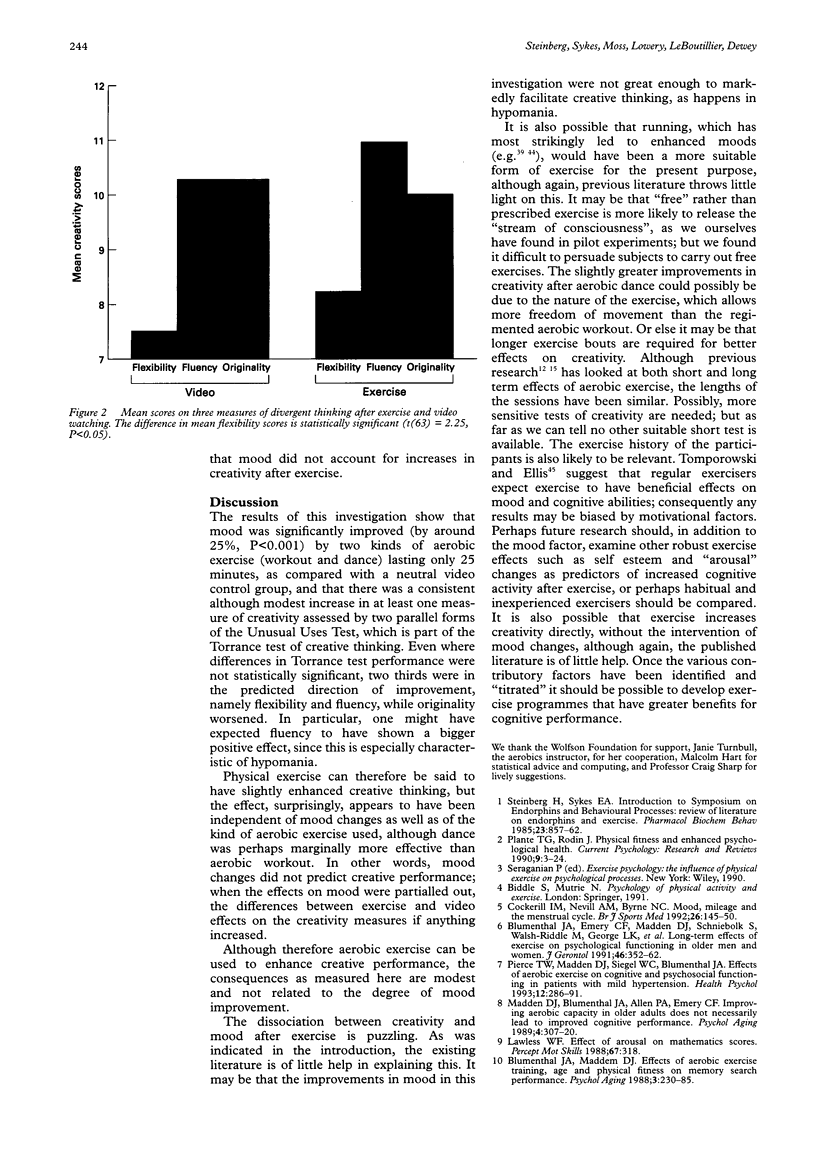
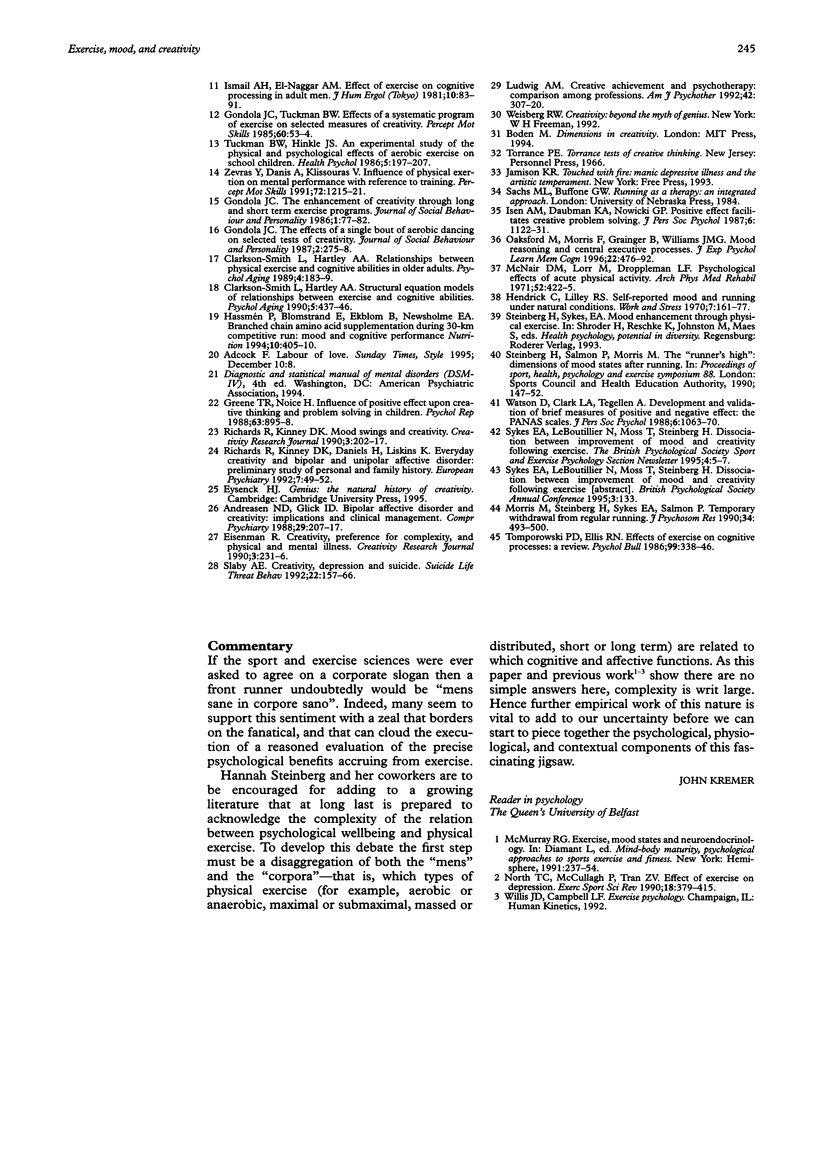
Images in this article
Selected References
These references are in PubMed. This may not be the complete list of references from this article.
- Andreasen N. C., Glick I. D. Bipolar affective disorder and creativity: implications and clinical management. Compr Psychiatry. 1988 May-Jun;29(3):207–217. doi: 10.1016/0010-440x(88)90044-2. [DOI] [PubMed] [Google Scholar]
- Clarkson-Smith L., Hartley A. A. Relationships between physical exercise and cognitive abilities in older adults. Psychol Aging. 1989 Jun;4(2):183–189. doi: 10.1037//0882-7974.4.2.183. [DOI] [PubMed] [Google Scholar]
- Clarkson-Smith L., Hartley A. A. Structural equation models of relationships between exercise and cognitive abilities. Psychol Aging. 1990 Sep;5(3):437–446. doi: 10.1037//0882-7974.5.3.437. [DOI] [PubMed] [Google Scholar]
- Cockerill I. M., Nevill A. M., Byrne N. C. Mood, mileage and the menstrual cycle. Br J Sports Med. 1992 Sep;26(3):145–150. doi: 10.1136/bjsm.26.3.145. [DOI] [PMC free article] [PubMed] [Google Scholar]
- Gondola J. C., Tuckman B. W. Effects of a systematic program of exercise on selected measures of creativity. Percept Mot Skills. 1985 Feb;60(1):53–54. doi: 10.2466/pms.1985.60.1.53. [DOI] [PubMed] [Google Scholar]
- Hassmén P., Blomstrand E., Ekblom B., Newsholme E. A. Branched-chain amino acid supplementation during 30-km competitive run: mood and cognitive performance. Nutrition. 1994 Sep-Oct;10(5):405–410. [PubMed] [Google Scholar]
- Isen A. M., Daubman K. A., Nowicki G. P. Positive affect facilitates creative problem solving. J Pers Soc Psychol. 1987 Jun;52(6):1122–1131. doi: 10.1037//0022-3514.52.6.1122. [DOI] [PubMed] [Google Scholar]
- Ismail A. H., El-Naggar A. M. Effect of exercise on cognitive processing in adult men. J Hum Ergol (Tokyo) 1981 Sep;10(1):83–91. [PubMed] [Google Scholar]
- Morris M., Steinberg H., Sykes E. A., Salmon P. Effects of temporary withdrawal from regular running. J Psychosom Res. 1990;34(5):493–500. doi: 10.1016/0022-3999(90)90023-w. [DOI] [PubMed] [Google Scholar]
- Pierce T. W., Madden D. J., Siegel W. C., Blumenthal J. A. Effects of aerobic exercise on cognitive and psychosocial functioning in patients with mild hypertension. Health Psychol. 1993 Jul;12(4):286–291. doi: 10.1037//0278-6133.12.4.286. [DOI] [PubMed] [Google Scholar]
- Slaby A. E. Creativity, depression and suicide. Suicide Life Threat Behav. 1992 Summer;22(2):157–166. [PubMed] [Google Scholar]
- Tuckman B. W., Hinkle J. S. An experimental study of the physical and psychological effects of aerobic exercise on schoolchildren. Health Psychol. 1986;5(3):197–207. doi: 10.1037//0278-6133.5.3.197. [DOI] [PubMed] [Google Scholar]
- Watson D., Clark L. A., Tellegen A. Development and validation of brief measures of positive and negative affect: the PANAS scales. J Pers Soc Psychol. 1988 Jun;54(6):1063–1070. doi: 10.1037//0022-3514.54.6.1063. [DOI] [PubMed] [Google Scholar]
- Zervas Y., Danis A., Klissouras V. Influence of physical exertion on mental performance with reference to training. Percept Mot Skills. 1991 Jun;72(3 Pt 2):1215–1221. doi: 10.2466/pms.1991.72.3c.1215. [DOI] [PubMed] [Google Scholar]




